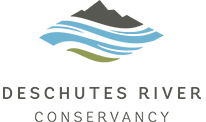-
What is the Deschutes River Conservancy?
The Deschutes River Conservancy (DRC) is a 501(c)3 non-profit corporation founded in 1996. Our mission is to restore streamflow and improve water quality in the Deschutes Basin. Water management is one of the most important issues facing Central Oregon today.
Sort Order: 010
-
What are the problems that the DRC is addressing?
Nearly 90% of the streamflow from the Deschutes River in Bend can be diverted through irrigation canals during the irrigation season (April - October). During the summer months, these diversions cause a dramatic reduction in streamflow. The porous, volcanic soil characteristic of this region causes as much as 50% of the water that is diverted from the river in irrigation canals to seep into the ground before it reaches the farm. As a result, irrigation districts need to divert twice the amount of water as they need to serve their patrons. These seasonal flow disruptions have contributed to a decline in the overall health of the river including degraded fish habitat and poor water quality.
Sort Order: 020
-
How does the DRC restore our local rivers and streams?
The DRC employs four market-based, innovative programs to restore our local rivers and streams: the Leasing Program, Conserved Water Program, and the Transfers Program.
Sort Order: 040
-
How can water users conserve water?
Water users can conserve water by either applying less water to their land or by reducing leaks in canals while transporting irrigation water.
Sort Order: 050
-
What types of conservation projects are there?
There are two main categories: piping and lining canals and on-farm efficiency projects such as converting from flood irrigation to sprinkler or drip irrigation.
Sort Order: 060
-
What are the benefits of the Conserved Water Program?
The program promotes the conservation of water, maximizes the beneficial use of water, and enhances streamflows by requiring that at least 25% of water saved by a water conservation project be protected permanently instream.
Sort Order: 070
-
How is the conserved water allocated?
The state receives 25% and the applicant receives 75% of the conserved water unless the applicant proposes a higher allocation to the state. Most DRC funded projects allocate 100% to the state for instream use.
Sort Order: 080
-
Will my water right be affected by the allocation of conserved water?
Your new water right will show the changes made for the conserved water. The water right retains its original priority date or can be one minute after that of the original right.
Sort Order: 090
-
If my original water right is for irrigation, can I use the conserved water for another use?
Yes, as long as the new use is identified as a beneficial use. Keep in mind that surface water rights for irrigation will always be limited to the irrigation season identified in the original right.
Sort Order: 100
-
How do I apply for the conserved water program?
Application forms are available at www.oregon.gov/owrd.
Sort Order: 120



